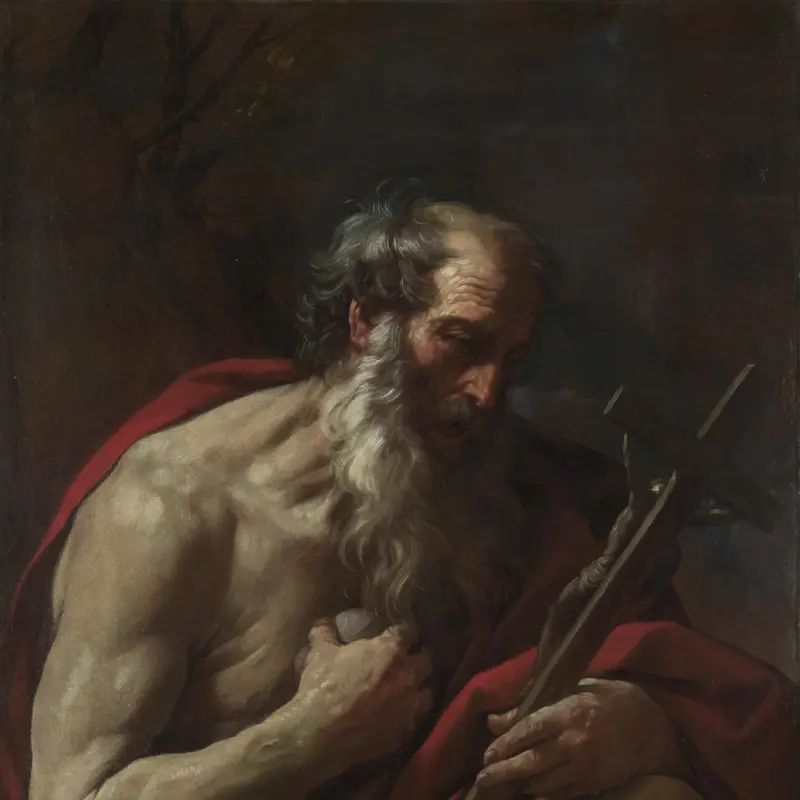Guido Reni, 'The Coronation of the Virgin', about 1607
About the work
Overview
Paintings of the coronation of the Virgin Mary typically show her being crowned by Christ and God the Father, often accompanied by the Holy Ghost in the form of a dove. This work, however, mixes elements of the coronation with those of Mary’s assumption (when angels carried her body and soul to heaven three days after her death). Attended by angels, the Virgin sits on a throne of clouds. Winged putti carry the crown, perhaps preparing to bestow the title Regina angelorum (‘Queen of the angels’) upon her.
This composition is a development of an earlier Assumption and Coronation of the Virgin of similar dimensions, painted by Guido Reni in about 1602–3 (Museo del Prado, Madrid). That painting is on panel, whereas the National Gallery’s small-scale scene is on copper. Reni began to paint on copper in the early 1590s and was considered especially successful at it – its smooth, hard surface allowed the artist to paint in minutely fine detail.
Key facts
Details
- Full title
- The Coronation of the Virgin
- Artist
- Guido Reni
- Artist dates
- 1575 - 1642
- Date made
- About 1607
- Medium and support
- Oil on copper
- Dimensions
- 66.6 × 48.8 cm
- Acquisition credit
- Bequeathed by William Wells, 1847
- Inventory number
- NG214
- Location
- Room 26
- Collection
- Main Collection
- Previous owners
- Frame
- 17th-century Italian Frame
Provenance
Additional information
Text extracted from the ‘Provenance’ section of the catalogue entry in Michael Levey, ‘National Gallery Catalogues: The Seventeenth and Eighteenth Century Italian Schools’, London 1986; for further information, see the full catalogue entry.
Exhibition history
-
2016Painters' Paintings: From Freud to Van DyckThe National Gallery (London)23 June 2016 - 4 September 2016
-
2022Guido Reni: The Beauty of the DivineStädelsches Kunstinstitut und Städtische Galerie23 November 2022 - 5 March 2023Museo Nacional del Prado28 March 2023 - 9 July 2023
Bibliography
-
1831Catalogue of Pictures by Italian, Spanish, Flemish, Dutch, and English Masters, with which the Proprietors have Favoured the Institution, June 1831, London 1831
-
1831British Institution, Catalogue of Pictures by Italian, Spanish, Flemish, Dutch, and English Masters with which the Proprietors have Favoured the Institution (exh. cat. British Institution, 1831), London 1831
-
1849M. Bryan, Dictionary of Painters, London 1849
-
1850National Gallery, A Catalogue of Pictures in the National Gallery, London 1850
-
1853National Gallery, Report from the Select Committee on the National Gallery, together with the Proceedings of the Committee, Minutes of Evidence, Appendix, and Index, London 1853
-
1853London, National Gallery Archive, NG15/3: Report from the Select Committee on the National Gallery, together with the Proceedings of the Committee, Minutes of Evidence, Appendix, and Index, 1853
-
1854G.F. Waagen, Treasures of Art in Great Britain: Being and Account of the Chief Collections of Paintings, Drawings, Sculptures, Illuminated Mss. […], vol. 2, trans. E. Eastlake, London 1854
-
1854R.N. Wornum and C.L. Eastlake, Descriptive and Historical Catalogue of the Pictures in the National Gallery, with Biographical Notices of the Painters, London 1854
-
1878H. Blackburn, Illustrated Catalogue to the National Gallery: Foreign Schools, London 1878
-
1888E.T. Cook, A Popular Handbook to the National Gallery Including, by Special Permission, Notes Collected from the Works of Mr. Ruskin, London 1888
-
1906Half Holidays at the National Gallery, 5th edn, London 1906
-
1930W.T. Whitley, Art in England 1821-1837, Cambridge 1930
-
1937O. Kurz, 'Guido Reni', Jahrbuch der Kunsthistorischen Sammlungen in Wien, II, 1937, pp. 189-220
-
1955C. Gnudi and G.C. Cavalli, Guido Reni, Florence 1955
-
1961K. Andrews, 'An Early Guido Reni Drawing', The Burlington Magazine, CIII, 1961, pp. 461-5
-
1965A.E. Pérez Sánchez, Pintura italiana del s. XVII en España, Madrid 1965
-
1969D.S. Pepper, 'Guido Reni's Early Style', The Burlington Magazine, CXI, 1969, pp. 472-83
-
1970P. Matthiesen and D.S. Pepper, 'Guido Reni: An Early Masterpiece Discovered in Liguria', Apollo, 1970, pp. 452-62
-
1971E. Baccheschi, L'opera completa di Guido Reni, Milan 1971
-
1971M. Levey, The Seventeenth and Eighteenth Century Italian Schools, London 1971
-
1978D. Robertson, Sir Charles Eastlake and the Victorian Art World, Princeton 1978
-
1983M. Helston, Spanish and Later Italian Paintings, London 1983
-
1983National Gallery, 'Pictures Cleaned and Restored in the Conservation Department of the National Gallery, January 1983 – December 1983', National Gallery Technical Bulletin, VIII, 1984, pp. 71-2
-
1984D.S. Pepper, Guido Reni: A Complete Catalogue of His Works, Oxford 1984
-
1986Levey, Michael, National Gallery Catalogues: The Seventeenth and Eighteenth Century Italian Schools, London 1986
-
1986M. Helston, 'Some Recently Cleaned Seicento Paintings at the National Gallery', The Burlington Magazine, CXXVIII/996, 1986, pp. 209-17
-
1988D.S. Pepper, Guido Reni: L'opera completa, Novara 1988
-
2001
C. Baker and T. Henry, The National Gallery: Complete Illustrated Catalogue, London 2001
About this record
If you know more about this work or have spotted an error, please contact us. Please note that exhibition histories are listed from 2009 onwards. Bibliographies may not be complete; more comprehensive information is available in the National Gallery Library.










